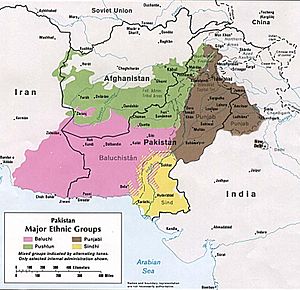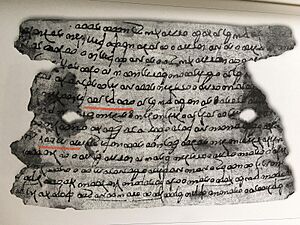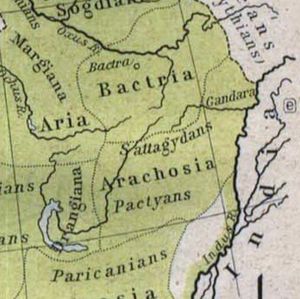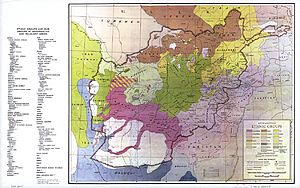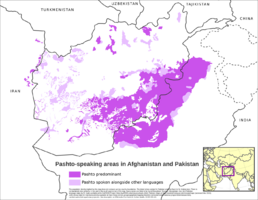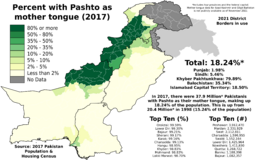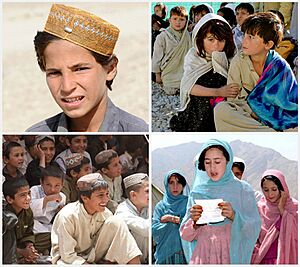Pashtuns facts for kids
| پښتانه | |
|---|---|
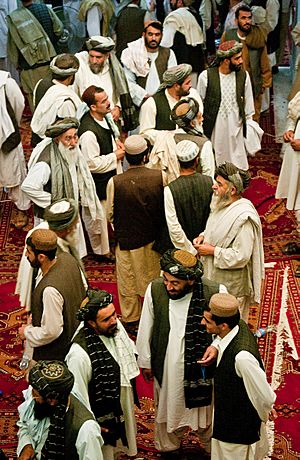
Number of Pashtun Tribal and religious men in Southern Afghanistan
|
|
| Total population | |
| c. 63 million | |
| Regions with significant populations | |
| 40,097,131 (2023) | |
| 18,831,361 (2023) | |
| 3,200,000 (2018) [primarily non-Pashto speaking estimates] 21,677 (2011) [Pashto speakers] |
|
| 169,000 (2022) | |
| 538,000 (2021) | |
| 100,000 (2009) | |
| 32,400 (2017) | |
| 31,700 (2021) | |
| 19,800 (2015) | |
| 12,662 (2021) | |
| Languages | |
| Pashto in its different dialects: Wanetsi, Central Pashto, Southern Pashto, Northern Pashto | |
| Religion | |
| Majority: Sunni Islam Minority: Shia Islam, Hinduism, Sikhism |
|
| Related ethnic groups | |
| Other Iranic peoples | |
The Pashtuns (also called Pakhtuns or Pathans) are a large ethnic group mainly living in Pakistan and Afghanistan. They are known for their unique language, Pashto, and their strong cultural code called Pashtunwali.
Historically, Pashtuns were sometimes called "Afghans." This changed in the 1970s when "Afghan" became a term for anyone from Afghanistan. Today, there are about 49 million Pashtuns worldwide. They are a very important group in both Pakistan and Afghanistan.
Contents
Where Do Pashtuns Live?
Pashtuns in Pakistan and Afghanistan
Pashtuns live across a wide area, from the Amu River in the north to the Indus River in the east. You can find them in many cities in Pakistan and Afghanistan.
Major cities with many Pashtuns include Jalalabad, Kandahar, Peshawar, and Quetta. Pashtuns also live in big cities like Kabul, Karachi, and Islamabad.
Karachi, Pakistan's financial hub, has the largest group of Pashtuns living in a city anywhere in the world. Islamabad, the capital, also has a large Pashto-speaking community.
Pashtuns in India
In India, Pashtuns are often called Pathans. Many Indian Pathans are descendants of Pashtun soldiers who settled in India long ago. Some experts believe there are twice as many Pathans in India as there are Pashtuns in Afghanistan.
Historically, Pashtuns settled in many Indian cities like Mumbai, Delhi, and Kolkata. These settlers came from areas that are now Pakistan and Afghanistan. In some parts of India, they are known as Kabuliwala.
The Rohilkhand region in Uttar Pradesh is even named after the Rohilla community, who have Pashtun roots. Large groups of Pashtuns also live in Maharashtra and West Bengal.
Some Pashtuns even traveled to places like Trinidad and Tobago, Surinam, Guyana, and Fiji in the 19th century. They went there to work in sugarcane fields. Many stayed and formed new communities.
Today, Pashtuns are found all over India. After India was divided in 1947, many moved to Pakistan. Most Indian Pashtuns now speak Urdu and have blended into local Indian society. They have made important contributions to Indian politics, entertainment, and sports.
Pashtuns in Iran
Smaller groups of Pashtuns live in eastern and northern Iran. Some historical records show Durrani Pashtuns in Iran as early as the 1600s.
After a short period when Ghilji Pashtuns ruled parts of Iran in the 1700s, many were moved to northern Iran. Their descendants still live there, though they have mostly blended in.
Pashtuns Around the World
Many Pashtuns from India and Pakistan have moved to other countries, especially the United Kingdom, Canada, and Australia. This started around the 1960s.
Some Pashtuns have also settled in the Middle East, particularly in the Arabian Peninsula. Many Pashtuns are part of the larger Pakistani and Afghan communities living abroad.
What Does "Pashtun" Mean?
Old Names: "Pakthās" and "Pactyans"
The name "Pashtun" has very old roots. An ancient tribe called Pakthās is mentioned in a very old Indian text called the Rigveda, around 1500 to 1200 BCE. These people fought in a famous battle called the "Battle of the Ten Kings."
Later, around 430 BCE, a Greek historian named Herodotus wrote about a tribe called Pactyans. These Pactyans lived in the area that is now Afghanistan. They were known as a very warlike group.
Other ancient writers also mentioned similar names, suggesting that the ancestors of Pashtuns have been in the region for thousands of years.
The Name "Afghan"
For a long time, especially in the Middle Ages, Pashtuns were often called "Afghans." The word "Afghan" might come from an old Sanskrit word, Aśvakan, which means "horsemen" or "horse breeders." This name was used for people living in the Hindu Kush mountains.
The earliest mention of "Afghan" (as Abgân) is from the 3rd century CE by the Sassanid Empire. In the 4th century, ancient documents from northern Afghanistan also mention "Afghans."
Later, in the 6th century CE, an Indian astronomer mentioned "Avagāṇa" (Afghans). The name also appeared in a 10th-century book, Ḥudūd al-ʿĀlam, which described a village where "Afghans" lived.
In the 11th century, the historian Al-Biruni wrote about rebellious Afghans living west of the Indus River. Many Afghans also joined the armies of rulers like Mahmud of Ghazni. By the 13th century, Afghans were well-known in northern India.
Pashtun History and Origins
The exact origin of the Pashtun people is not fully clear, and there are many different ideas. Most modern scholars believe that Pashtuns don't all come from the same single origin. Instead, they might be a mix of old Iranian tribes that spread across the region.
Some historians think that the Pashtuns are a group of different tribes that came together over time. It's like exploring the source of a big river; there might not be just one starting point.
Language Clues
The Pashto language is part of the Eastern Iranian language family. It has some similarities to ancient languages like Bactrian and Sogdian. Some experts suggest Pashto might have come from a language similar to Khotanese, which was spoken by the Saka people.
This suggests that the original Pashto speakers might have been a group of Saka people.
Diverse Ancestry Ideas
Some theories suggest that Pashtuns might have come from a mix of different groups. These could include Persians, Greeks, Turks, Arabs, and even ancient peoples like Scythians and Huns.
Some Pashtun tribes believe they are descended from Arabs. There are also old stories that link Pashtuns to ancient Egyptians, but there's no strong proof for this.
Greek Connections?
Some studies suggest that a small part of Pashtuns might have Greek ancestors. This could be from Greeks who came with Alexander the Great's army around 330 BCE.
Some Pashtuns in Peshawar and Kandahar even believe they are direct descendants of these Greek soldiers.
Hephthalite Links?
The Ghilji tribe, one of the largest Pashtun groups, has been linked to the Khalaj people. Some historians believe the Khalaj might be descendants of the Hephthalites, who were a powerful group in Central Asia long ago.
The Durrani tribe, another major Pashtun group, might also have connections to the Hephthalites.
Oral Traditions and Israelite Theory
Many Pashtun tribes have an oral tradition that they are descended from the ancient Israelites. This story says that when the twelve tribes of Israel were scattered, some, like the tribe of Joseph, settled in Afghanistan. The tribal name Yusufzai even means "son of Joseph."
This idea has been written about by historians for centuries. However, many modern scholars and genetic studies do not support this theory. They say the historical records are not consistent, and the genetic evidence points to an Indo-Iranian origin for Pashtuns.
Pashtuns in Modern Times

Pashtuns have a rich modern history, playing key roles in various empires and states. They were important in the Delhi Sultanate and later formed their own powerful empires, like the Hotak dynasty and the Durrani Empire. The Durrani Empire, founded by Ahmad Shah Durrani, covered much of what is now Afghanistan, Pakistan, and parts of India and Iran.
In the 19th century, during a time called "The Great Game" (when the British and Russian empires competed for influence), Pashtuns in Afghanistan managed to keep some independence. However, the Durand Line was drawn, dividing Pashtun lands between British India (now Pakistan) and Afghanistan.

In the 20th century, many Pashtun leaders in British India supported India's independence movement. Figures like Khan Abdul Ghaffar Khan, known as "Bacha Khan," led non-violent resistance movements. Other Pashtuns worked with the All India Muslim League for an independent Pakistan.
Afghanistan gained full independence from British influence in 1919. Later, in the 1950s, there was a call for "Pashtunistan," which caused tensions between Afghanistan and the new state of Pakistan.
In 1973, Mohammed Daoud Khan took control of Afghanistan, pushing a Pashtun nationalist agenda. This led to a period of conflict. In 1978, Daoud Khan was killed in a coup. The Soviet Union then intervened in Afghanistan in 1979, leading to a long war. Many Pashtuns became Afghan mujahideen fighters, supported by countries like the United States. Millions of Pashtuns also became refugees in Pakistan and Iran, and many moved to other parts of the world.
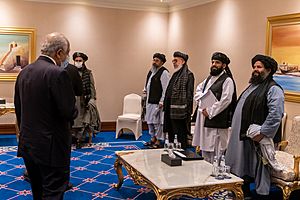
After the Soviet withdrawal, Afghanistan continued to face conflict. The Taliban regime, largely made up of Pashtuns, ruled Afghanistan from 1996 to 2001. After the US-led invasion in 2001, new governments were formed, with many Pashtuns holding important positions.
Today, Pashtuns continue to be key figures in politics in both Afghanistan and Pakistan. Many have also become famous in sports, literature, and entertainment. For example, Imran Khan, a former Pakistani Prime Minister, is a Pashtun. Malala Yousafzai, the youngest Nobel Peace Prize winner, is also a Pakistani Pashtun.
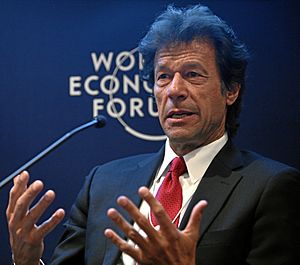
Many Bollywood film stars in India, like Aamir Khan and Shah Rukh Khan, have Pashtun ancestry.
What Makes Someone a Pashtun?
There are a few main ways Pashtuns define who belongs to their group:
- Speaking Pashto: Being able to speak and use the Pashto language is a very important part of Pashtun identity.
- Following Pashtunwali: This is a traditional code of conduct that guides Pashtun life. It includes rules about hospitality, honor, justice, and bravery.
- Family Lineage: Belonging to a Pashtun tribe through your father's side is also a key definition. This means that if your father is Pashtun, you are considered Pashtun.
Pashtun Tribes
The Pashtun people have a complex system of tribes. These tribes are organized into larger groups, which are then divided into smaller family groups called khels. Each khel has many extended families.
Durrani and Ghilji Pashtuns
The Durranis and Ghiljis (or Ghilzais) are the two biggest groups of Pashtuns. About two-thirds of Afghan Pashtuns belong to these two groups. The Durranis have often been more involved in city life and politics. The Ghiljis are more numerous, live more in rural areas, and are known for being very tough.
These two groups have sometimes worked together and sometimes fought each other throughout history. For a long time, Durranis ruled Afghanistan. Later, in 1978, the new communist rulers were Ghilji.
Pashto Language
Pashto is the main language for most Pashtuns. It is one of the two official languages of Afghanistan. In Pakistan, even though many people speak Pashto, it is often not used much in the official education system. This can make it harder for Pashtun students to learn.
Pashto is an Eastern Iranian language. It has many unique words and a complex grammar compared to other Iranian languages. There are many different Pashto dialects, usually divided into Northern, Southern, and Central groups.
The first Pashto alphabet was created in the 16th century. In 1958, scholars from Afghanistan and Pakistan agreed on the standard Pashto alphabet used today.
Pashtun Culture
Pashtun culture is built on Pashtunwali, the Islamic faith, and the Pashto language. Poetry has been a very important part of Pashtun culture for centuries.
Some traditions, like traditional dances, might even go back to before Islam. Music and literary styles show influences from Persian culture, mixed with local Pashtun styles. Like other Muslims, Pashtuns celebrate Islamic holidays. In Afghanistan, Pashtuns also celebrate Nowruz, the Afghan New Year.
Jirga: The Grand Council
A very important part of Pashtun society is the jirga (or lóya jirgá, meaning 'grand council'). This is a meeting of elected elders. Most decisions in tribal life are made by the jirga. It is the main group that Pashtuns respect and follow.
Religion

Before Islam, Pashtuns practiced different beliefs like Zoroastrianism, Buddhism, and Hinduism. Today, most Pashtuns are Sunni Muslims and follow the Hanafi school of thought.
There are small groups of Shia Muslims among Pashtuns, especially in certain tribes like the Turi and Bangash. Sufism, a mystical branch of Islam, has also influenced some Pashtun regions.
Many Pashtuns are important Islamic scholars. Some Pashtuns are working to show that their culture and history are separate from negative stereotypes often linked to certain groups.
There are also Hindu Pashtuns, sometimes called Sheen Khalai (meaning 'blue skinned'). Many of them moved to India after the partition of India in 1947. They still speak Pashto and celebrate Pashtun culture. A small number of Pashtuns are also Sikhs.
Pashto Literature and Poetry

Most Pashtuns speak Pashto as their first language. It is written using a special Pashto-Arabic script. The language has ancient roots and shares similarities with very old languages.
Poetry helped Pashto literature grow. In the 20th century, Pashto literature became very important, with poets like Ameer Hamza Shinwari developing new forms of poetry. The first Pashto newspaper in Afghanistan, Seraj-al-Akhbar, was published in 1919.
Famous Pashtun poets include Khushal Khan Khattak, Rahman Baba, and Nazo Tokhi.
Media and Arts
Pashto media has grown a lot in recent years. There are now many Pashto TV channels, like AVT Khyber and Pashto One, which are popular among Pashtuns worldwide. Channels like Shamshad TV and Lemar TV in Afghanistan even have children's shows. International news sources like BBC Pashto also offer programs in Pashto.
Pashto-language films have been made in Peshawar since the 1970s.
Pashtuns love to express themselves through dance and other physical activities. One of the most famous dances is Attan, which is very old. Dancers move in a fast circle while musicians play drums, percussions, and string instruments. Other dances are specific to different tribes.
Sports
Cricket is a very popular sport among Pashtuns. Many Pashtuns play for the national cricket teams of Pakistan and Afghanistan. Famous Pashtun cricketers include Imran Khan, Shahid Afridi, and Rashid Khan.
Makha is a traditional archery sport played in Khyber Pakhtunkhwa, Pakistan. In Afghanistan, some Pashtuns still play buzkashi, a game where horse riders try to carry a goat or calf carcass to a goal.
Pashtun Women
Pashtun women are often known for their modesty and honor. Their lives can be very different depending on whether they live in traditional rural areas or modern cities. In villages, a female leader called a "qaryadar" helps with women's ceremonies and solves conflicts.
While many Pashtun women in rural areas are traditional and may not have much education, some have gone to universities and work in various professions.
The long wars in Afghanistan and the rise of the Taliban caused many difficulties for Pashtun women. Their rights were often limited by strict interpretations of Islamic law. The famous "Afghan Girl" photo on National Geographic showed the hard lives of Afghan female refugees.
Modern efforts to improve women's rights began in the early 20th century with Queen Soraya Tarzi of Afghanistan. She worked to improve women's lives and their place in society. Later, in the 1970s, feminist leaders like Meena Keshwar Kamal campaigned for women's rights.
Today, Pashtun women range from traditional housewives to urban workers who seek equal rights with men. However, many still face challenges, and literacy rates for women are lower than for men. Women's rights organizations are working to address these issues.
Some Pashtun women have achieved high positions in politics and the military. For example, Nigar Johar is a three-star general in the Pakistan Army. Many Pashtun women are also TV hosts, journalists, and actors. Famous Indian actresses like Madhubala and Zarine Khan have Pashtun ancestry.
Notable Pashtuns
See also
 In Spanish: Pueblo pastún para niños
In Spanish: Pueblo pastún para niños


